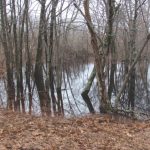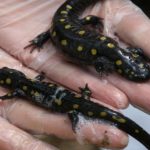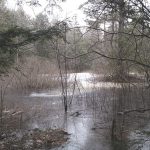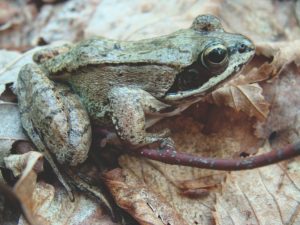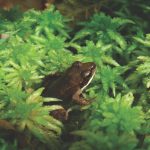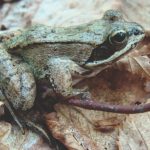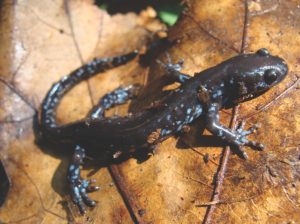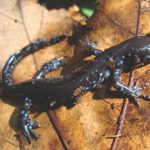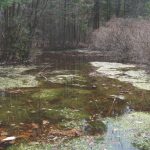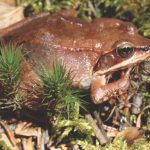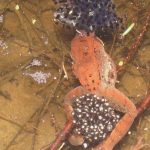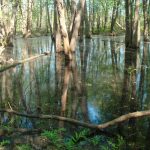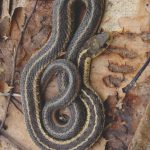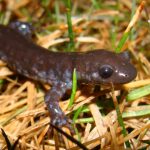Vernal Pools
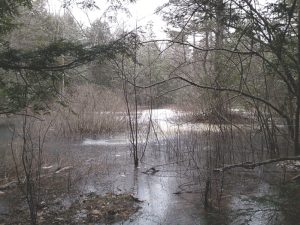 What is a vernal pool, and why should Maine people care about protecting them? Based on research at the University of Maine, the Vernal Pools 4-H Science Toolkit includes activities that take youth from learning about biodiversity, to recognizing what a vernal pool is and how scientists determine if a pool is significant. Instructions and materials for visiting and collecting samples from a vernal pool are included!
What is a vernal pool, and why should Maine people care about protecting them? Based on research at the University of Maine, the Vernal Pools 4-H Science Toolkit includes activities that take youth from learning about biodiversity, to recognizing what a vernal pool is and how scientists determine if a pool is significant. Instructions and materials for visiting and collecting samples from a vernal pool are included!
Are you interested in learning more about what the University of Maine and UMaine system campuses offer?
The University of Maine offers over 100 academic majors! To learn more either:
Visit UMaine’s Find a Major.
Explore our other campuses here.
If you need help connecting to UMaine or one of the other UMaine System campuses, contact us by email or call (207) 581-3877 and ask for Laura, Greg, or Sarah!
Video: 4-H Science Tool Kit: Vernal Pools (YouTube)
Curriculum Activities
Activity 1: Ecology
Objectives:
 At the end of this lesson youth should be able to answer:
At the end of this lesson youth should be able to answer:
- What is a vernal pool?
- Why are vernal pools important and what role do they play in the ecosystem?
- How to identify vernal pools and the animals that live there?
- How are vernal pools linked to human interests/activities?
- Explain the key stages of wood frog metamorphosis
Time to complete activity: 60 minutes
Background/Setting the Stage: 15 minutes
Ask the youth if they have ever been in the woods and seen a random pool of water? Do any of them know what it is or how it got there?
Then, facilitate a discussion, and ask the youth the following questions:
- Where can we find water?
- How does water move through different environments?
- What are some ways plants and animals depend on water?
- What are some ways people depend on water?
These questions should lead into the activity by examining how water in vernal pool habitats is a finite resource only available for a certain period of time in the year. While scarce most of the year, the presence of water in the spring leads to an explosion of life at vernal pools.
Materials:
- Vernal Pool power point (see visuals folder)
- computer and projector
- Vernal Pool Indicator Species ID cards
Methods
Vernal Pool Trivia (20-30 minutes)
- Present pictures of two water bodies, one a vernal pool and the other of some other type of water body. Ask youth to identify similarities and differences between the two bodies of water. Record youth responses on a whiteboard in a Venn diagram. (five minutes)
- After discussing the similarities and differences, present youth with the formal definition of a vernal pool used by various state agencies. Have them record these definitions in their vernal journals. (five minutes)
- Vernal pools are naturally occurring, temporary to semi-permanent pools occurring in shallow depressions in forested landscapes. Vernal pools provide the primary breeding habitat for wood frogs, blue spotted and spotted salamanders, and fairy shrimp and provide habitat for other wildlife, including several endangered and threatened species.
- Pools were defined as “naturally occurring” so that skidder ruts, farm ponds, recent gravel pits, and roadside ditches would not be considered vernal pools. Amphibians will lay their eggs in some of these human-made wetlands, but they are not the primary breeding habitat.
- Key characteristics of vernal pools
- Size <0.1 to two acres (small pool to about the size of ¾ of a football field)
- Hydrology seasonal, no permanent inlet/outlet
- Fish Absent
- Breeding wood frogs, blue spotted and spotted salamanders, fairy shrimp
- Vernal pools are naturally occurring, temporary to semi-permanent pools occurring in shallow depressions in forested landscapes. Vernal pools provide the primary breeding habitat for wood frogs, blue spotted and spotted salamanders, and fairy shrimp and provide habitat for other wildlife, including several endangered and threatened species.
- Present the series of photographs of water bodies from the PowerPoint presentation and ask youth to make informed guesses as to whether they would be classified as a vernal pool or not using these characteristics. (five minutes)
- Once youth are familiar and comfortable with the definition of a vernal pool show them the next slides depicting vernal pools through the various seasons.
- After going through the seasons ask youth why they think vernal pools are called vernal pools. (two minutes)
- Define vernal as coming from Latin for spring. This is the time that water begins to appear in the pools.
- Now pass out the vernal pool indicator species identification cards and have youth brainstorm what is meant by indicator species.
- Discuss how we could classify these different organisms (e.g., frogs/salamanders as amphibians and fairy shrimp as crustaceans, primary/secondary consumers, etc.) (three to five minutes)
- Discuss the various roles these organisms may play in the vernal pool habitat. This is a good opportunity to explain that while these are the indicator species for vernal pools they are not the only living things within the vernal pool environment. This should help clarify the term indicator species as well as inform youth about the other plants and animals that live in vernal pools. (five minutes)
- These species as consumers:
- What do you suspect they eat?
- Are they the only organisms that utilize vernal pools?
- What else might live in vernal pools?
- These species as prey:
- What do you suspect consumes these organisms?
- What makes vernal pools a great habitat for these creatures to spawn and live in?
- Sheltered from fish & fast moving water, an abundance of insect food, etc.
- What adaptations do you suspect they have to live in a vernal pool habitat?
- How do they survive the winter?
- How might the existence or absence of these animals affect human life?
- Sketch Vernal Pool web of life map
- These species as consumers:
- Ask youth to brainstorm ways in which the vernal pool might be destroyed and record responses for all youth to see. (5 minutes)
- Natural Events
- e.g., flooding, drought, hurricane, etc.
- Human Events
- e.g., filling in the depressing, development, deforestation, pollution, etc.
- Natural Events
Reflection Questions (Journal or Discussion)
General
- What is a vernal pool?
- What animals breed in vernal pools?
- Why do they breed there?
- How are humans and vernal pools linked?
Middle School
- How would a drought or a dry winter and spring effect wood frog populations? (MS-LS2-1)
- How would this affect other animals?
- How would it affect humans?
- For the frogs, which round was most difficult? Why? (MS-LS2-1)
- Which round was easiest?
- Does this accurately reflect a real vernal pool? How? (MS-LS2-1)
- How does the amount of water in the vernal pool determine where and how far a wood frog can go?
- Or how does the wood frog’s environment affect its development? (MS-LS1-5)
High School
- What effect do you think heavy logging would have on a vernal pool? (HS-LS2-6)
- Would it get filled in? If so, what would start to live there?
- Would it still be a place where water gathered?
- How does climate relate to vernal pool indicator species? (HS-LS2-6)
- How would changes in climate affect the number of species?
Supplemental Information:
- Conserving Maine’s Significant Wildlife Habitat, Vernal Pools (PDF) (Maine Audubon website)
- The Ecology of Vernal Pools (PDF)
Vocabulary:
Vernal Pool: Naturally occurring, temporary to semi-permanent pools occurring in shallow depressions in forested landscapes. Vernal pools provide the primary breeding habitat for wood frogs, blue-spotted and spotted salamanders, and fairy shrimp and provide habitat for other wildlife including several endangered and threatened species.
Indicator Species: A species whose presence can be used to identify a particular habitat or various aspects of that habitat Vernal Pool indicator species are:
Wood Frog: A small frog, often less than 2.5 inches that often inhabit vernal pool habitats. They are identified by a dark face mask and white lip line. They are the first frogs to emerge from hibernation in upland forests cued by warm spring rains.
Spotted Salamander: A large dark-colored salamander that has bright yellow spots. They use vernal pools to lay their eggs. Their eggs vary in color due to genetic variation and a symbiotic relationship with algae (Oophilia amblystomatis)
Fairy Shrimp: Small freshwater crustaceans that grow up to one inch in length. They are usually found in pools with shorter hydro-periods and are uncommon in pools in Maine (<5% statewide)
Blue Spotted Salamander: A small dark salamander with well-defined light blue spots. They are often hybridized with the Jefferson salamander. Hybrids tend to be larger and more brownish in color.
Hydrology: The distribution and characteristics of water on land and in the atmosphere.
Activity 2: Web of Life
At the end of this activity youth should be able to:
- Discuss why vernal pools are ecologically important
- Identify the ways different organisms depend on each other
- Evaluate the role of water in the vernal pool ecosystem
- Identify the first source of all the energy in the vernal pool
Time to complete activity: 30-45 minutes
Background/Setting the Stage:
- What are some things you ate today? (Jot these down on the board.)
- Have youth reflect on where these things come from. Explain that we are looking to see where the energy to produce them came from, not necessarily where they were bought.
- Are these things eventually all connected to plants?
- Where do plants get their energy?
Materials:
- ball of yarn or string
- Vernal Pool cards
- wood frog tadpole, rain, ice, sun, blue-spotted salamander, fairy shrimp, spotted salamander egg, great blue heron, white pine tree, algae, dead leaf, red squirrel, human, painted turtle, red-tailed hawk, fox, grass, snowshoe hare, porcupine, red maple tree, dragonfly nymph, mosquito.
Methods
Vernal Pool Web of Life (20 minutes)
- Have the youth gather in a circle, seated or standing.
- Hand to each youth one of the vernal pool web of life cards and explain that they are now going to make some of the connections they made in the pre-activity questions, only this time they will be an organism or resource in a vernal pool.
- After every youth has a card, have one youth volunteer to explain how his/her card is related to another card in the circle. For example, a wood frog tadpole is connected to algae because algae is consumed by the wood frog tadpole. Youth could take this a step further and make connections such as a wood frog tadpole is connected to the sun because it eats algae, which uses the sun to produce energy for itself.
- Once a youth has explained a connection between his/her card and another youth’s card, he/she will pass the ball of yarn to that youth while holding onto the end of the string.
- The youth now holding the ball of string makes a connection between his/her card and a new card in the circle. He/she then passes the ball of yarn to that youth while holding onto the string.
- As this activity progresses the string will form a web in the middle of the circle.
- Optional: After the youth have made a lot of connections you can introduce a stressor that limits availability or pollutes the environment’s resources, such as drought, deforestation, pollution, etc. Ask the youth with the card(s) affected by this stressor to drop their string. Ask youth to reflect on how this environmental stressor affects the web of life.
Reflection Questions (Journal or Discussion)
Once all youth have made a connection has the group reflect on the connections they have made.
- In what ways are vernal pools important to organisms that live away from them? (MS-LS2-2)
- How do different organisms depend on each other? (MS-LS2-2)
- What role does water have in the vernal pool ecosystem? (MS-LS2-3)
- What is the first source of all the energy in the vernal pool? (MS-LS1-6)
Supplemental Information:
- Diversity and Ecology of Vernal Pool Invertebrates (ResearchGate website), ‘Download full-text PDF’ button in upper right hand corner.
- Conserving Maine’s Significant Wildlife Habitat: Vernal Pools (PDF) (Maine Audubon website)
Vocabulary:
- Interdependence: A mutually dependent relationship.
- Food Web: a system of interlocking and interdependent food chains.
- Environmental stressor: A natural or man-made strain on an environment’s resource.
Activity 3: Town Hall
At the end of this activity youth should be able to:
- Identify various community interests in vernal pool ecology and landscapes
- Articulate how human actions affect the resources on which vernal pool organisms depend for their survival
- Identify the complex relationships between vernal pool habitats and the organisms and environments outside of that habitat
Time to complete activity: 60-90 minutes
Background/Setting the Stage:
- Who in a community might care about where vernal pools are and what happens to them?
- Who stands to lose if certain forests cannot be developed because they contain vernal pools?
- What are the potential consequences of development?
- What groups might want to protect vernal pools?
Materials:
No materials needed for this activity.
Methods
Vernal Pool Town Hall
Reedville is a small town of 900 people located in mid-coast Maine. The population of the town has grown steadily over the past few years, as a large company in a nearby city has attracted more people to the area. In Reedville, however, jobs are limited and the town is struggling to fund schools without raising taxes.
Ethel McRose, a long-time resident of Reedville, has recently passed away at the ripe old age of 112. She has left behind 200 acres of land that is almost entirely forested. The land provides habitat for many plants and animals. The extensive forest contains many vernal pools providing critical habitat for wood frogs, spotted salamanders, and yellow spotted salamanders. Ethel had let a team of University of Maine scientists use the vernal pools as study sites. She also let a group of local hunters use her land during hunting season. Ethel has willed the land to the town, asking that it be used in a way that is most beneficial to the community and environment.
There are many groups interested in purchasing Ethel’s property. There is a town meeting today for the various stakeholders to hear the proposals of these various interested groups. At the end of the meeting, youth will act as citizens of Reedville and vote on which proposal they think would be most beneficial to their town and environment. [Note: The facilitator should inform the interest groups that they must make a “sales pitch” to the stakeholders and convince them to vote for their proposal.]
- Town Manager Introduction- the facilitator (five to ten minutes)
- Read the introduction aloud to youth
- Outline the activity on the whiteboard/chalkboard
- Briefly introduce each interest group and stakeholder group
- Then assign youth to specific groups or have them organize themselves in appropriately- sized groups
- Prepare Proposals (20 minutes)
- Youth assigned an interest group to decide together what they plan to do with the property. Each interest group prepares an opening statement that includes what organization they are representing and their proposal for the McRose property. They should also include how their plan will affect the town and environment. Youth should include a brief description of their plan in their vernal journals
- Questions (10 minutes)
- Youth assigned as a stakeholder group are required to ask each interest group a question that is relevant to their concerns. The questions are then written on a piece of paper with the interest group they are directed towards and given to the Town Manager so that she/he can distribute them to the proper interest group. In their vernal journals, each stakeholder group should record the questions they are asking of each interest group.
- Answers (20 minutes)
- The interest groups will have 10 minutes to come up with answers to the stakeholders’ question. The remaining ten minutes allows each group to quickly answer the questions and put in one last plug for their organization’s proposal.
- These should also be recorded in their vernal journals. Vote (five minutes)
- The Town Manager will oversee a vote by the various stakeholders in what proposal they would approve. The final vote is by a simple majority rule by stakeholder groups.
Interest Groups (two to four youth each)
- Build-A-New-World Construction Company
This Maine-based group of builders has its eye on the many fine building sites on Ethel’s property. They would like to develop a subdivision including as many homes sites as possible. - The Nature Savery
This environmental organization purchases plots of land to maintain wild areas and prevent development. They have been working to protect land in the surrounding Reedville area. - Timber Incorporated
This group would like to purchase the rights to harvest the rich stands of Red Oak and White Pine on the McRose property. - Recreation Unlimited
The owners of a mega-resort in New Hampshire would like to purchase Ethel’s property. To build a recreation area with many small cabins or perhaps room for RVs or camping, and to allow for motorized sports and other recreational activities.
Stakeholder Groups (two to three youth)
- Citizens of Reedville
The citizens of Reedville are particularly interested in seeing job growth in their community. They also have a long history of preserving their local environment and do not want to see their local ecosystems damaged. - UMaine Vernal Pool Scientists
The UMaine scientists would like to continue their research on Ethel’s land as it has been a valuable site for conducting research. They also have an interest in preserving the surrounding habitat as changes in the forest could affect the vernal pool habitat. - Hunters of Reedville
The hunters of Reedville have been using Ethel’s property for many years and would like to continue hunting on the property. Many of the best hunting sites are in the most remote parts of the property and are not easily accessible.
Activity 4: Data Entry
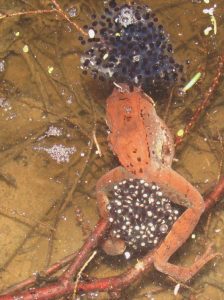 Objectives:
Objectives:
At the end of this activity youth should be able to:
- Identify specific variables needed to classify a vernal pool as “significant”
- Identify potential obstacles to gathering data about a vernal pool
Time to complete activity: 60 minutes
Background/Setting the Stage:
- How can we tell if something is a vernal pool?
- Are all vernal pools alike?
- Are some more important than others? If so, how?
Materials:
- game board
- game pieces
- municipal data form
Video: 4-H Science Tool Kit: Vernal Pools (YouTube)
Methods
Data Entry Game
- Begin by reviewing with youth key characteristics of vernal pools. Vernal pools range in size from two acres to a tenth of an acre. They are formed in the spring when meltwater drains into shallow depressions. They have no inlets or outlets, and they have no permanent fish populations—making them ideal breeding habitats for wood frogs, fairy shrimp, spotted salamanders, and blue-spotted salamanders.
- Your discussion of vernal pool characteristics should lead naturally to a review of the criteria that define significant vernal pools. According to the Natural Resources Protection Act, in order to be considered significant a vernal pool must have at least one of the characteristics below:
- Wood frog: 40 or more egg masses
- Spotted salamander: 20 or more egg masses
- Blue-spotted salamander: 10 or more egg masses
- Fairy shrimp: Presence
- Once youth know the criteria used to define a “significant” vernal pool, ask youth why we might want to protect them. The point of this part of the activity is just to get youth thinking about why and how significant vernal pools differ from other vernal pools.
- Why don’t we protect other vernal pools?
- Is that okay?
- Could we enforce protections on that broad of a scale?
- Could an ‘insignificant’ vernal pool become ‘significant’?
- Once youth have a grasp on the definition, guide them through the following visualization:
- On a cool spring morning, you and a friend take a walk through a local forest. As you are walking you notice through the trees a depression in the land. You tell your friend that you want to go check it out, and so you both slowly make your way through the trees until you reach this shallow depression in the forest. The winter snow has melted, and you notice that the depression has a good amount of cool, clear water. You have heard rumors that a local development agency would like to convert this forest into a subdivision for new homes, and so you say to your friend, “Hey, I wonder if this is going to be paved over when they build those new homes.” Your friend responds “Yeah…maybe. Remember when we learned about vernal pools? I think that if this were a significant vernal pool, it would be protected from being developed.”
- Now ask youth, “what things would you want to know about this pool of water in order to classify it as a significant vernal pool?” Have them write down some of their ideas in their vernal journals.
- Divide youth into groups of three. Working together, have each of them create a data sheet that could be used in the field to collect information about vernal pools. The variables on the data sheets should correspond to the criteria for identifying significant vernal pools. For example, “spotted salamander egg masses” should be one of the variables.
- Instruct groups that their data sheets should be designed to record information on four separate vernal pools. In total, data sheets should have five columns: the first one for the variable and the next four for the vernal pools. It may be a good idea to display an example row on the chalkboard so that youth understand what they need to do.Wood frog egg masses: VP 1______ / VP 2_______ / VP 3______ / VP 4 ______
- After youth have constructed their data sheets, hand out the vernal pool game board and pieces. The game requires one youth to construct privately a vernal pool. During this process, the youth should place on the game board various indicator species. He should also place a multiplier next to the species or egg mass, to indicate the number of that particular item. For example, if the “X 20” multiplier is placed next to a wood frog egg mass piece, there are twenty egg masses at that site. The youth can choose to use as many or as few indicator species and multipliers as she or he wishes.
Reflection Questions (Journal or Discussion)
Have youth reflect on the data collection experience in their vernal journals.
Prompt youth with the following questions and have them record their responses in their vernal journals:
General and Middle School
- How did you identify specific variables and why did you choose them? (MS-ETS1-1, HS-ETS1-2)
- Which variables were helpful? Why? (MS-ETS1-1, HS-ETS1-2)
- Were there variables that you wish you had included? Why? (MS-ETS1-2)
- Which variables did you include that were not needed? Why? (MS-ETS1-2)
- How do the forms you created differ from the municipal forms? (MS-ETS1-3)
- How are they similar?
- Was the municipal form easier or harder to use? Why or why not? (MS-ETS1-3)
- Did the municipal form make it easier to determine whether or not the pool was significant? Why or why not? (MS-ETS1-3)
High School
- How might knowing the variables you came up with and those on the data form be used to conserve vernal pools? (HS-ETS1-2)
- How could the individual pieces of data be used to study a larger issue like climate change or watershed pollution? (HS-ETS1-2)
Supplemental Information:
As an instructor, it would be important to familiarize yourself with the state’s definition of a ‘significant vernal pool’ and the state’s data sheets used to determine whether or not a pool is significant. The University of Maine’s website has a wealth of information including a brief Vernal Pool Regulation in Maine: Answers to Frequently Asked Questions (PDF) (Of Pools and People website) Moreover, the website contains complete annotated presentations on how to fill out both the Municipal Vernal Pool Data Form 2010, Powerpoint slides (PDF) (Of Pools and People website) and Maine Department of Inland Fisheries and Wildlife (MDIFW) Significant Vernal Pool Data Sheet (PDF) data sheets. It may be important to clarify that all significant vernal pools are protected whether or not landowners give permission for assessment.
University of Maine Vernal Pools site: Of Pools and People website
Vocabulary:
Vernal Pool: Naturally occurring, temporary to semi-permanent pools occurring in shallow depressions in forested landscapes. Vernal pools provide the primary breeding habitat for wood frogs, blue-spotted and spotted salamanders, and fairy shrimp and provide habitat for other wildlife including several endangered and threatened species.
Significant Vernal Pool: A vernal pool that contains specific numbers of indicator species breeding or the presence of a rare, threatened, or endangered species.
Variable: A value of a specific data point that may change within the scope of a study.
Species Abundance: A significant predetermined value for individual indicator species breeding numbers or presence in a vernal pool.
Activity 5: Site Visit
 Objectives:
Objectives:
At the end of this activity, youth should be able to:
- Use prior knowledge to identify vernal pool habitat by key characteristics
- Identify indicator species and relate previous knowledge of the organisms life cycle to observations made in the field using field ID cards
- Collect and input accurate field data using provided data sheets
Time to complete activity: 90-120 minutes
Background/Setting the Stage:
- Facilitate a discussion, in which youth review important concepts covered in the previous activity.
- What are the key characteristics of vernal pools?
- What are the four indicator species?
- What are the criteria for “significance”?
Materials:
- waterproof cameras
- Maine Vernal Pool Indicator Species cards
- dip nets and magnifying glasses
- frisbees (to collect samples)
- Maine Gazetteer and field guides
- graph paper
- Muck boots or waders (youth will need to bring their own)
- measuring wheel/tape (to measure the size of the vernal pool)
Methods
Site Visit
First review major concepts from previous activities (5 minutes)
- Ask youth for the key parameters used to define vernal pools
- Vernal Pool Ecology
- Key Characteristics
- Size: from a tenth of an acre to 2 acres
- Hydrology: Seasonal, no permanent inlet or outlet
- Defined by the species that breed there
- Wood Frogs
- Blue-spotted salamanders
- Spotted Salamanders
- Fairy Shrimp
- Pools are free of permanent fish populations
- Excluded pond, streams, beaver flowages, man-made water bodies
- Key Characteristics
- Vernal Pool Ecology
Next, pass out the Maine Vernal Pool Indicator Species cards and have youth, in groups, go through the cards one by one. Using the cards, have youth discuss the ways they will be able to identify the various organisms and egg masses. Examples are listed below. (15 minutes).
- Wood Frog
- Raccoon mask on face with white lip line
- Small- Less than 2.5 inches long
- Wood Frog Eggs
- Newly laid egg masses are small and compact (about the size of a golf ball). They will quickly expand to reach a maximum size of approximately 5 inches/softball size
- Black or dark brown in color from above, underside is contrasting white or cream color
- Attached to grasses, cattails, sticks and branches in pool
- Can be deposited on the pool bottom in deeper water
- Appearance like bubbles, tapioca pudding or marbles
- Wood Frog Tadpoles
- Often seen in shallow pools
- Small, dark, and numerous
- No additional tadpoles are in pools in early spring when wood frogs hatch
- Spotted Salamander
- Dark colored body with bright yellow spots
- Spotted Salamander spermatophores
- Male salamanders deposit spermatophores on leaf litter and submerged sticks
- Spotted Salamander Eggs
- 10-100 eggs in each mass
- Jelly like coating around the egg mass
- Attached to submerged vegetation
- 1-3 egg masses in a group
- Blue Spotted Salamander
- Dark slender body with bright blue spots
- Blue Spotted Salamander Eggs
- Egg masses are difficult to see below the water surface and may not be visible without gently lifting
- Submerged vegetation
- Drippy, transparent jelly surround each mass
- May be deposited individually along the bottom of the pool or in small clusters along submerged sticks
- Hybrid Blue-Spotted Salamander
- Often brownish-grey and larger bodied than blue-spotted salamanders, hybrids have varying amounts of light blue flecking
- Hybrid Blue-Spotted Salamander Egg
- Often containing white infertile embryos, hybrid egg masses may be deposited in the long strings of ‘pearls’ along submerged vegetation
- Fairy Shrimp
- Grow up to an inch in length
- Often seen swimming upside down in sunny pool shallows
- Eggs: deposited in the spring need to dry and freeze before they hatch when pools refill in spring
- Much more common in southern New England; only 5% of Maine pools surveyed contain
After introducing different organisms, give youth some tools (dip nets, guides, magnifying glasses, etc.) for exploring the pool. Remind youth that these pools are vitally important habitats and they should take great efforts to reduce their impact on the environment. This includes watching where they step so as not to disturb egg masses, not handling amphibians, not removing any plant material, etc. Tell them that they will reconvene shortly but this is a time for them to freely explore the pond. (15 minutes)
When youth reconvene, explain that they are trying to see if the vernal pool could be considered “Significant.” Provide the youth with the following parameters (10 minutes):
Significance is determined by either species abundance or rarity of the species present (Chapter 335, of Significant Wildlife Habitat Rules).
Species Abundance Criteria
- Fairy Shrimp: presence in any life stage
- Blue-Spotted Salamanders: presence of 10 or more egg masses
- Spotted Salamanders: presence of 20 or more egg masses
- Wood Frogs: presence of 40 or more egg masses
Group youth into various research teams that will collect data around the pond. Review the data sheet if necessary (5-8 minutes) (this step can/should be completed before going into the field to expedite this process)
Depending on group size individual research teams might vary in number but each group should have:
- one photographic team(two to four youth)
- one mapping team (two to three youth)
- three-plus teams Monitoring Indicator Species/Egg Mass presence (three to four youth/team)
- Photographic Team
- Will take photographs of pool site and surrounding habitat, showing what the pool looks like:
- Also, have youth:
- Compile a list of common plants/animals present, using the field guide. If they cannot identify the plant in the field, have them take a picture and they can later research the plant using a guidebook
- Write a description of what the surrounding land looks like
- Make note of any human impacts on the pool (i.e. ditches, trails, roads, trash, etc.)
- Also, have youth:
- Will photograph each egg mass type found in the pool
- Photograph fairy shrimp if present
- Will take photographs of pool site and surrounding habitat, showing what the pool looks like:
- Mapping Team
- Will complete the mapping section of the data sheet, which requires this team to:
- Locate pool location on Gazetteer
- Map the pool to scale using graph paper and measuring wheel/tape (they may need help scaling the pond to the size of the graph paper). The map should highlight:
- Location of the Indicator Species/Egg Mass monitoring team’s transect areas
- Locations of any human disturbances (trails, roads, lawns, ditches, trash, etc.)
- Surrounding land topography
- Other identifying characteristics
- Obtain GPS location of pool’s center (if possible)
- Using the measuring tape or wheel, extend on map 250ft and/or 750ft radius, again including:
- Locations of any human disturbances (trails, roads, lawns, ditches, trash, etc.)
- Surrounding land topography
- Other identifying characteristics
- Extrapolate pool size estimations, including area and depth
- Will complete the mapping section of the data sheet, which requires this team to:
- Indicator species/Egg mass identification Teams
- Will complete the data entry sheet
- Should divide pool into separate transect areas and accurately complete data sheet for their specific transect area.
- Transects should all be the same length. The length of the transects will change depending on the size of the pool, but they should all be the same length for each pool studied. Transects should run alongside the pool or through the pool, depending on how prepared youth are for getting into the pool (muck boot)
- Youth can examine egg masses using the indicator species Frisbees as small trays
- Youth should take care when moving through the pool and cause as little disturbance as possible. They should not handle amphibians. They should collect other organisms they find in the pond such as insects
- These youth can also pull some representative specimens out to the dish pans for others to see at the end of the visit
- Should divide pool into separate transect areas and accurately complete data sheet for their specific transect area.
- Will complete the data entry sheet
Have youth work on their specific tasks and assist when/where needed. (30-60 minutes)
Reflection Questions (Journal or Discussion)
Have youth gather back up. Have a group conversation about their individual tasks.
Possible prompts could include:
- What indicator species were found?
- How many egg masses were found?
- What are some of the physical characteristics of this pool?
- In what ways do you suppose those characteristics have affected the health of the pool?
- What are potential human and environmental factors that would affect the overall health of this pool?
- Is the pool healthy? Why or why not?
- What did the youth learn about when collecting field data?
- How has their perception of vernal pools changed since first learning about them?
- Was it what they had expected?
Collect youth’s materials, including data sheets, for future use, and ensure that all supplies have been gathered from the pool.

 This activity is supported by National Science Foundation award #EPS-0904155 to Maine EPSCoR at the University of Maine.
This activity is supported by National Science Foundation award #EPS-0904155 to Maine EPSCoR at the University of Maine.

